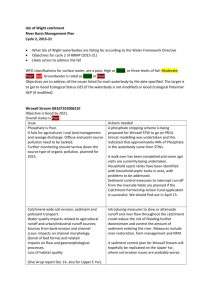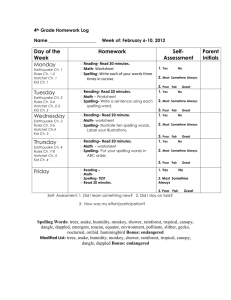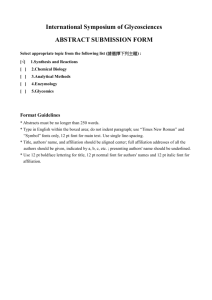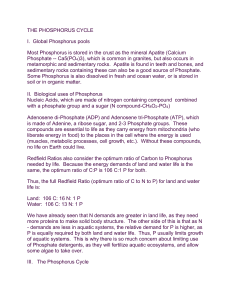Water Body Summary Sheet - Catchment Change Network
advertisement
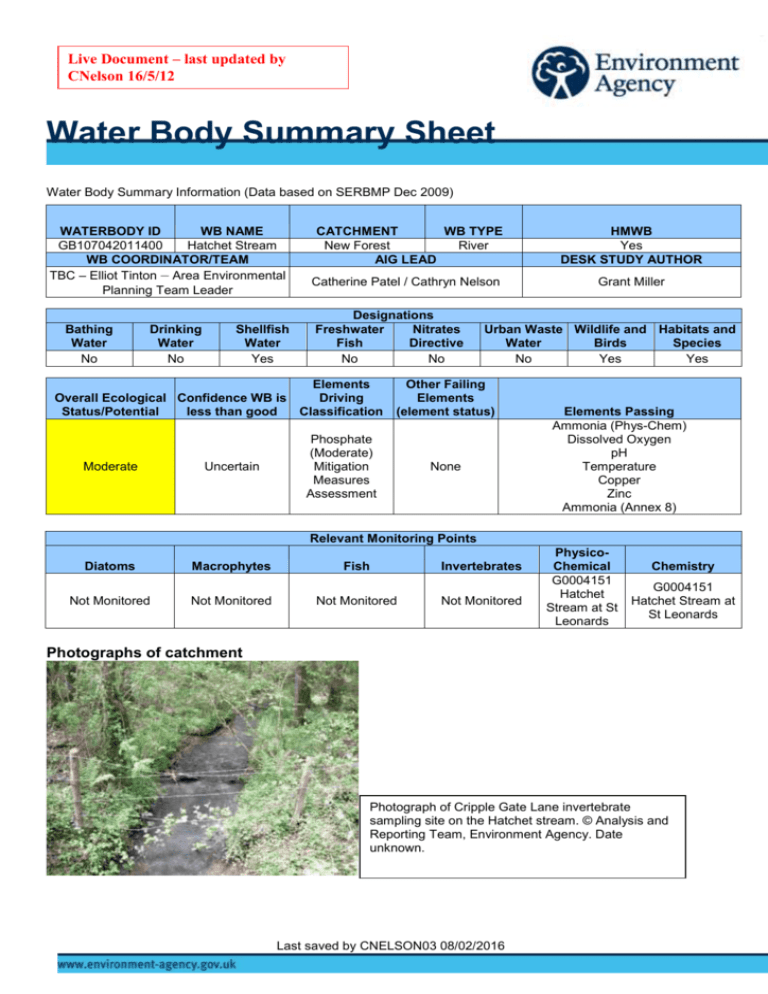
Live Document – last updated by CNelson 16/5/12 Water Body Summary Sheet Water Body Summary Information (Data based on SERBMP Dec 2009) WATERBODY ID WB NAME GB107042011400 Hatchet Stream WB COORDINATOR/TEAM TBC – Elliot Tinton – Area Environmental Planning Team Leader Bathing Water No Drinking Water No Shellfish Water Yes CATCHMENT WB TYPE New Forest River AIG LEAD HMWB Yes DESK STUDY AUTHOR Catherine Patel / Cathryn Nelson Grant Miller Designations Freshwater Nitrates Fish Directive No No Elements Overall Ecological Confidence WB is Driving Status/Potential less than good Classification Moderate Uncertain Urban Waste Wildlife and Habitats and Water Birds Species No Yes Yes Other Failing Elements (element status) Phosphate (Moderate) Mitigation Measures Assessment None Elements Passing Ammonia (Phys-Chem) Dissolved Oxygen pH Temperature Copper Zinc Ammonia (Annex 8) Relevant Monitoring Points Diatoms Macrophytes Fish Invertebrates Not Monitored Not Monitored Not Monitored Not Monitored PhysicoChemical G0004151 Hatchet Stream at St Leonards Chemistry G0004151 Hatchet Stream at St Leonards Photographs of catchment Photograph of Cripple Gate Lane invertebrate sampling site on the Hatchet stream. © Analysis and Reporting Team, Environment Agency. Date unknown. Last saved by CNELSON03 08/02/2016 Situation BACKGROUND = The Hatchet Stream runs for approximately 8.9km through a rural area, upon Headon Beds and Osborne Beds. Hatchet Pond (Lake water body ID: GB30745652) is at the top of this water body. It is the presence of Hatchet Pond that means this water body is designated as Heavily Modified. The reasons for this designation are Flood Protection and Water Regulation – Impoundment Release. STATUS = Current Ecological Potential is moderate. The objective is for good ecological potential to be achieved by 2027. Having undertaken this desktop investigation, it is not thought likely that this water body will achieve good potential by 2015. PRESSURES = New Zealand Pigmy Weed (Crassula helmsii) is present around Hatchet pond so, therefore, Hatchet stream is probably at risk from Alien species. The IRBM database states that this water body is at risk from combined source nutrients and probably at risk from diffuses sources, such as agriculture. This water body also is physically and morphologically altered. FAILING ELEMENT OVERVIEW = The following is a summary of the current situation for each failing element. This was last updated on 11th June 2010. Phosphate – Phosphate has been classed as moderate for this water body and predicted to remain so in 2015. Phosphate has been of moderate status since 2007 and the annual mean of phosphate has been rising since 2007. The most likely source for this phosphate is from East Boldre Sewage Treatment Works. Hatchet Pond is not considered to be a major source of Phosphate, as it achieves high phosphate status under WFD. There is some agricultural and horticultural practice within the catchment, but this is of low intensity and it is not believed that they are major sources of phosphate. Looking at the phosphate trends over a year, the phosphate levels at the physicochemical site do appear to be correlated with the peaks and troughs of Phosphate discharge from the sewage works. Currently there are no phosphate limits on East Boldre’s consent discharge. As site specific regulatory action is potentially expensive, further evidence is needed to identify and confirm that East Boldre STW is causing the Hatchet Stream to fail WFD Phosphate standards. Actions tied into SE0200 will investigate phosphate levels above and below East Boldre STW. Mitigation Measures – There are currently no mitigation measures in place and suggested measures need to be scoped for feasibility:- Action SE0233 - 1 will address this. Designations – There are three protected areas within this water body - Solent and Southampton SPA, Solent Maritime SAC & The New Forest SAC . These protected areas are not meeting the requirements of Natura 2000. Measures have been identified to address the issues for the these protected areas and are detailed within the appendices and, also, are mentioned in annex D of the South East River Basin Management Plan. There are three designated sites (New Forest SPA, Ramsar and Solent & Southampton Water Ramsar) that haven’t been included within Annex D. Action NA3 will review these sites for inclusion into Annex D and thereby give further actions to improve/protect these areas. Alien Species – This water body has been identified as at risk from Alien Species, due to the presence of such species around Hatchet Pond. Actions to deal with these species associated with the pond will be covered in the Hatcher Pond Summary Sheet GB30745652. A walk-over survey of the Hatchet Stream would determine if there are aquatic alien plant species present within the Hatchet Stream (Action SE0201-1). WATER RESOURCES = WR WFD Stage 1 is a desktop study to confirm the flow compliance result is correct and ascertain whether the ecological monitoring sites are suitable for assessing abstraction impacts. The ecological status of suitable monitoring sites are noted. Those where flow non-compliance is confirmed and the ecological assessment indicates there is a potential hydroecological problem, progress to WR WFD Stage 2. WR WFD Stage 2 assesses the reasons for the failure and the water resource abstraction pressure upon the failing ecology. Water Resource WFD Stage 1 The flow compliance result in this water body has been assessed as compliant indicating that it supports ‘Good’ status. The ecology is assessed as failing but there is no clear evidence that this is due to flow. This water body will not pass to WR WFD investigations Stage2 (Identify cause of failure) KEY PARTNERS – Potentially Southern Water, if enough evidence is collected to confirm that East Boldre Sewage Treatment Works is having an ecological impact. Natural England are also a key partner, in regard to measures Situation addressing issues with Natura 2000 sites - Solent and Southampton SPA, Solent Maritime SAC and The New Forest SAC; Natural England will also be a partner in determining if the New Forest SPA, Ramsar and Solent Ramsar Sites should be included within Annex D. Water Body Action Team (to include external stakeholders where appropriate) Action ID Action Description RBMP Actions Identify priorities for second round of 'Regional Better Rivers Programme’. Outcome: Second planning cycle schemes improve habitat and ecology in SE0233 waters agreed from a pool of 53 candidates totalling 545 km, building on monitoring and lessons from the first round. Sub Actions Scoping what mitigation measures SE0233 - need to be implemented to deliver 1 Good Ecological Potential and identifying leads/functions/projects/partners to implement. WB Add on RBMP Action Carry out additional riverine sampling into the origins, causes of and solutions to pollution where we need to improve SE0200 certainty. Outcome: Improve our understanding of problems, in order to take effective action to address them. Contain and control invasive non-native species at priority sites through partnership working. Agree sites and action with the South East England NonNative Invasive Species Action Group. SE0201 Outcome: Spread of problem invasive species stopped and reversed, protecting important nationally and internationally designated habitats under threat from this pressure. Sub Actions Determine WFD-I programme to investigate phosphate from East Boldre SE0200-1 STW. Decide what parameters to measure and where Carry out the above WFD-I and SE0200-2 associated sampling SE0200-3 Analyse samples from investigation Analyse and interpret data from above SE0200-4 investigation Conduct walk-over survey of the Hatchet SE0201-1 Stream – are there any Alien Plant Species present? New Actions Classify this water body for invertebrates using 132364 Cripple Gate Lane as NA1 historic data is suitable for WFD classification. Water resources WFD investigation NA2 (Stage 1) Resource Estimate (FTE or £) Target Date Progress Name Team / Organisation This Project is not as far reaching as initially identified. Mitigation measures will cover this New Forest EA Virtual Group This Project is not as far reaching as 31 Dec initially 2011 identified. Mitigation measures will cover this New Forest EA Virtual Group 2015 See below See below See below See below See below See below 2011 Grant Miller A&R, EA 2011/12 Angie Vigor S&C, EA 2011/12 TBA A&R, EA 2011/12 Grant Miller A&R EA 2012 G. Miller & E. McSwan A&R, EA National EA Jim Whatley A&R EA 31/12/20 10 Done Water Body Action Team (to include external stakeholders where appropriate) Action ID Action Description NA3 Work with Natural England to populate Annex C Remedy Spreadsheet for the New Forest SAC & SPA Resource Estimate (FTE or £) Target Date Progress 2012 Name Team / Organisation T. Sykes FRB, EA & Natural England Adam Fulton A&R, EA Sub Actions Inform National of invertebrate data 2011 suitable for classification Redundant RBMP Actions (Of those listed above) Action ID Action Description Reason no longer relevant NA1-1 MM ID 47 44 37 29 20 16 6 Mitigation Measures (MM) Resource Target MM Description Estimate Date (FTE or £) Appropriate techniques to align and attenuate flow to limit detrimental effects of these features (drainage) Provide flows to move sediment downstream. Retain marginal aquatic and riparian habitats (channel alteration) Maintain sediment management regime to avoid degradation of the natural habitat characteristics of the downstream river. Operational and structural changes to locks, sluices, weirs, beach control, etc Structures or other mechanisms in place and managed to enable fish to access waters upstream and downstream of the impounding works. Increase in-channel morphological diversity Progress Name Team / Organisation Not in place EA Not in place EA Not in place EA Not in place EA Not in place EA Not in place EA Not in place EA Map of Catchment – Glossary A&R ASPT BIOSYS BMWP CEO CSF CSM CSO D/S DO EM EP FCS2 FRB HEVI LIFE NFPD NTAXA P RIVPACS RIVPACS SERBMP SS STP STW U/S WB WQIP WWTW Analysis and reporting team Average Score Per Taxa Our main database for storing, manipulating and reporting data from freshwater and marine biological surveys at any taxonomic level Biological Monitoring Working Party Combined emergency overflow Catchment sensitive farming Customer Self Monitoring (of STPs/WIMS sampling points) Combined sewer overflow Downstream Dissolved oxygen Environment management team Environmental planning team Fisheries Classification Scheme version 2 Fisheries recreation and biodiversity team HydroEcological Validation tool Lotic Invertebrate index for Flow Evaluation National Fish … Database Number of taxa Phosphate River InVertebrate Prediction and Classification System predicts the macro-invertebrate fauna at any site on a river from a small number of environmental parameters derived from maps or measured at the site. South East River Basin Management Plan Suspended solids Sewage treatment plant Sewage Treatment works Upstream Waterbody Water Quality Improvement Plan Waste water treatment works
